optimism sequencer背后的魔法:L2派生(derivation)原理
作者:joohhnnn
opstack是如何从Layer1中派生出来Layer2的
在阅读本文章之前,我强烈建议你先阅读一下来自optimism/specs中有关派生部分的介绍(source[2]) 如果你看完这篇文章,感到迷茫,这是正常的。但是还是请记住这份感觉,因为在看完我们这篇文章的分析之后,请你回过来头再看一遍,你就会发现这篇官方的文章真的很凝练,把所有要点和细节都精炼的阐述了一遍。
接下来让我们进入文章正题。我们都知道layer2的运行节点是可以从DA层(layer1)中获取数据,并且构建出完整的layer2区块数据的。今天我们就来讲解一下这个过程中是如何在codebase中实现的。
你需要有的问题
如果现在让你设计这样一套系统,你会怎么设计呢?你会有哪些问题?在这里我列出来了一些问题,带着这些问题去思考会帮助你更好的理解整篇文章
当你启动一个新节点的时候,整个系统是如何运行的?
你需要一个个去查询所有l1的区块数据吗?如何触发查询?
当拿到l1区块的数据后,你需要哪些数据?
派生过程中,区块的状态是怎么变化的?如何从
unsafe变成safe再变成finalized?官方specs中晦涩的数据结构
batch/channel/frame这些到底是干嘛的?(可以在上一章03-how-batcher-works章节中详细理解)
什么是派生(derivation)?
在理解derivation前,我们先来聊一聊optimism的基本rollup机制,这里我们简单以一笔l2上的transfer交易为例。
当你在optimism网络上发出一笔转账交易,这笔交易会被"转发"给sequencer节点,由sequencer进行排序,然后进行区块的封装并进行区块的广播,这里可以理解为出块。我们把这个包含你交易的区块称为区块A。这时的区块A状态为unsafe。接下来等sequencer达到一定的时间间隔了(比如4分钟),会由sequencer中的batcher的模块把这四分钟内所有收集到的交易(包括你这笔转账交易)通过一笔交易发送到l1上,并由l1产出区块X。这时的区块A状态仍然为unsafe。当任何一个节点执行derivation部分的程序后,此节点从l1中获取区块X的数据,并对本地l2的unsafe区块A进行更新。这时的区块A状态为safe。在经过l1两个epoch(64个区块)后,由l2节点将区块A标记为finalized区块。
而派生就是把角色带入到上述例子的l2节点当中,通过不断的并行执行derivation程序将获取的unsafe区块逐步变成safe区块,同时把已经是safe的区块逐步变成finalized状态的一个过程。
代码层深潜
hoho 船长,让我们深潜?
获取batcher发送的batch transactions的data
我们先来看看当我们知道一个新的l1的区块时,如何查看区块里面是否有batch transactions的数据 在这里我们先梳理一下所需要的模块,再针对这些模块进行查看
首先要确定下一个l1的区块块号是多少
将下一个区块的数据解析出来
确定下一个区块的块号
op-node/rollup/derive/l1_traversal.go
通过查询当前origin.Number + 1的块高来获取最新的l1块,如果此块不存在,即error和ethereum.NotFound匹配,那么就代表当前块高即为最新的区块,下一个区块还未在l1上产生。如果获取成功,将最新的区块号记录在l1t.block中
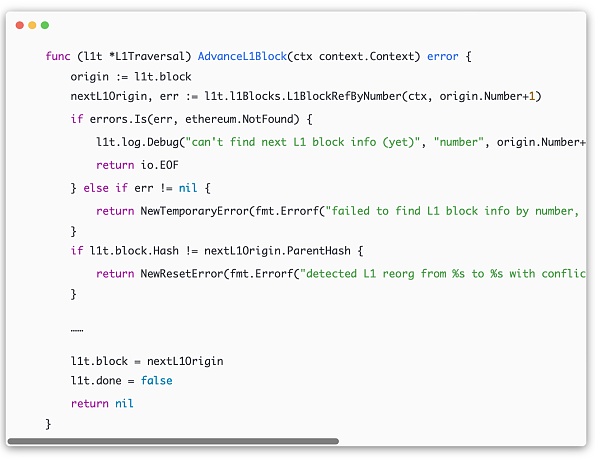
将区块的data解析出来
op-node/rollup/derive/calldata_source.go
首先先通过InfoAndTxsByHash将刚才获取的区块的所有transactions拿到,然后将transactions和我们的batcherAddr还有我们的config传入到DataFromEVMTransactions函数中, 为什么要传这些参数呢?因为我们在过滤这些交易的时候,需要保证batcher地址和接收地址的准确性(权威性)。在DataFromEVMTransactions接收到这些参数后,通过循环对每个交易进行地址的准确性过滤,找到正确的batch transactions。
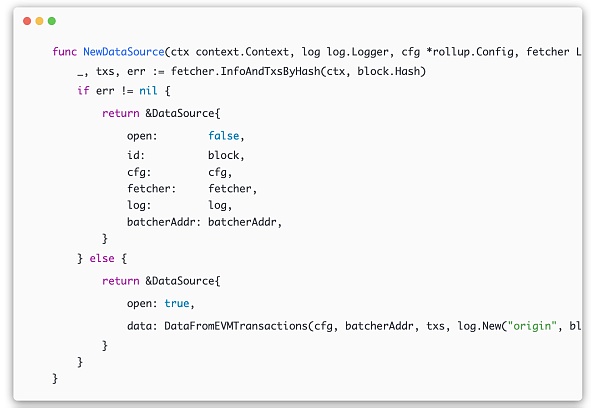
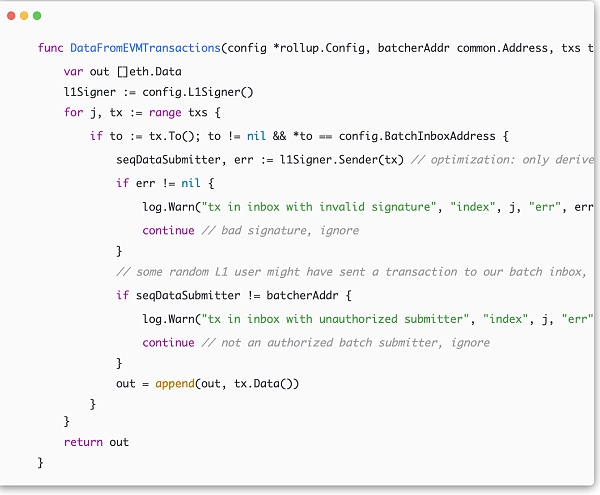
从data到safeAttribute,使unsafe的区块safe化
在这一部分,首先会将上一步我们解析出来的data解析成frame并添加到FrameQueue的frames数组里面。然后从frames数组中提取一个frame,并将frame初始化进一个channel并添加到channelbank当中,等待该channel中的frames添加完毕后,从channel中提取batch信息,把batch添加到BatchQueue中,将BatchQueue中的batch添加到AttributesQueue中,用来构造safeAttributes,并把enginequeue里面的safeblcok更新,最终通过ForkchoiceUpdate函数的调用来完成EL层safeblock的更新
data -> frame
op-node/rollup/derive/frame_queue.go
此函数通过NextData函数获取上一步的data,然后将此data解析后添加到FrameQueue的frames数组里面,并返回在数组中第一个frame。
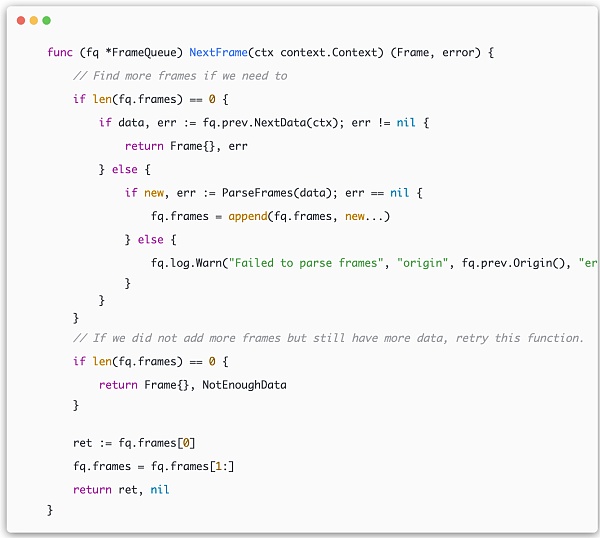
frame -> channel
op-node/rollup/derive/channel_bank.go
NextData函数负责从当前channel bank中读出第一个channel中的raw data并返回,同时负责调用NextFrame获取frame并装载到channel中
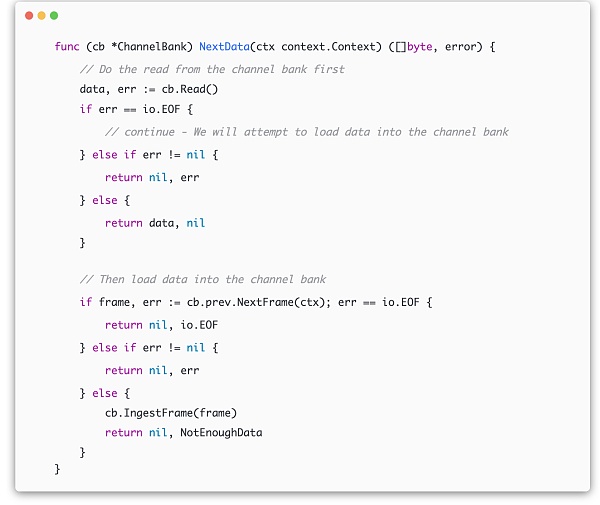
channel -> batch
op-node/rollup/derive/channel_in_reader.go
NextBatch函数主要负责将刚才到raw data 解码成具有batch结构的数据并返回。其中WriteChannel函数的作用是提供一个函数并赋值给nextBatchFn,这个函数的目的是创建一个读取器,从读取器中解码batch结构的数据并返回。

*注意❗️在这里NextBatch函数产生的batch并没有被直接使用,而是先加入了batchQueue当中,再统一管理和使用,并且这里的NextBatch实际由 op-node/rollup/derive/batch_queue.go 目录下的func (bq BatchQueue) NextBatch()函数调用
batch -> safeAttributes
补充信息:1.在layer2区块中,区块中的交易中的第一个永远都是一个锚定交易,可以简单理解为包含了一些l1的信息,如果这个layer2区块同时还是epoch中第一个区块的话,那么还会包含来自layer1的deposit交易([epoch中第一个区块示例](https://optimistic.etherscan.io/txs?block=110721915])。 2.这里的batch不能理解为batcher发送的batch交易。例如,我们在这里将batcher发送的batch交易命名为batchA,而在我们这里使用和讨论的命名为batchB,batchA和batchB的关系为包含关系,即batchA中可能包含非常巨量的交易,这些交易可以构造为batchB,batchBB,batchBBB等。batchB对应一个layer2中区块的交易,而batchA对应大量layer2中区块的交易。
op-node/rollup/derive/attributes_queue.go
NextAttributes函数传入当前l2的safe区块头后,将块头和我们上一步获取的batch传递到createNextAttributes函数中,构造safeAttributes。createNextAttributes中我们要注意的是,createNextAttributes函数内部调用的PreparePayloadAttributes函数,PreparePayloadAttributes函数主要负责,锚定交易和deposit交易的。最后再把batch的交易和PreparePayloadAttributes函数返回的交易拼接起来后返回
createNextAttributes函数在内部调用PreparePayloadAttributes
func (aq *AttributesQueue) NextAttributes(ctx context.Context, l2SafeHead eth.L2BlockRef) (*eth.PayloadAttributes, error) {
// Get a batch if we need it
if aq.batch == nil {
batch, err := aq.prev.NextBatch(ctx, l2SafeHead)
if err != nil {
return nil, err
}
aq.batch = batch
}
// Actually generate the next attributes
if attrs, err := aq.createNextAttributes(ctx, aq.batch, l2SafeHead); err != nil {
return nil, err
} else {
// Clear out the local state once we will succeed
aq.batch = nil
return attrs, nil
}
}
func (aq *AttributesQueue) createNextAttributes(ctx context.Context, batch *BatchData, l2SafeHead eth.L2BlockRef) (*eth.PayloadAttributes, error) {
……
attrs, err := aq.builder.PreparePayloadAttributes(fetchCtx, l2SafeHead, batch.Epoch())
……
return attrs, nil
}
func (aq *AttributesQueue) createNextAttributes(ctx context.Context, batch *BatchData, l2SafeHead eth.L2BlockRef) (*eth.PayloadAttributes, error) {
// sanity check parent hash
if batch.ParentHash != l2SafeHead.Hash {
return nil, NewResetError(fmt.Errorf("valid batch has bad parent hash %s, expected %s", batch.ParentHash, l2SafeHead.Hash))
}
// sanity check timestamp
if expected := l2SafeHead.Time + aq.config.BlockTime; expected != batch.Timestamp {
return nil, NewResetError(fmt.Errorf("valid batch has bad timestamp %d, expected %d", batch.Timestamp, expected))
}
fetchCtx, cancel := context.WithTimeout(ctx, 20*time.Second)
defer cancel()
attrs, err := aq.builder.PreparePayloadAttributes(fetchCtx, l2SafeHead, batch.Epoch())
if err != nil {
return nil, err
}
// we are verifying, not sequencing, we've got all transactions and do not pull from the tx-pool
// (that would make the block derivation non-deterministic)
attrs.NoTxPool = true
attrs.Transactions = append(attrs.Transactions, batch.Transactions...)
aq.log.Info("generated attributes in payload queue", "txs", len(attrs.Transactions), "timestamp", batch.Timestamp)
return attrs, nil
}
safeAttributes -> safe block
在这一步,会先engine queue中的safehead设置为safe,但是这并不代表这个区块是safe的了,还必须通过ForkchoiceUpdat在EL中更新
op-node/rollup/derive/engine_queue.go
tryNextSafeAttributes函数在内部判断是否当前safehead和unsafehead的关系,如果一切正常,则触发consolidateNextSafeAttributes函数来把engine queue中的safeHead 设置为我们上一步拿到的safeAttributes构造出来的safe区块,并将needForkchoiceUpdate设置为true,触发后续的ForkchoiceUpdate来把EL中的区块状态改成safe而真正将unsafe区块转化成safe区块。最后的postProcessSafeL2函数是将safehead加入到finalizedL1队列中,以供后续finalied使用。
func (eq *EngineQueue) tryNextSafeAttributes(ctx context.Context) error {
……
if eq.safeHead.Number < eq.unsafeHead.Number {
return eq.consolidateNextSafeAttributes(ctx)
}
……
}
func (eq *EngineQueue) consolidateNextSafeAttributes(ctx context.Context) error {
……
payload, err := eq.engine.PayloadByNumber(ctx, eq.safeHead.Number+1)
……
ref, err := PayloadToBlockRef(payload, &eq.cfg.Genesis)
……
eq.safeHead = ref
eq.needForkchoiceUpdate = true
eq.postProcessSafeL2()
……
return nil
}
将safe区块finalized化
safe区块并不是真的牢固安全的区块,他还需要进行进一步的最终化确定,即finalized化。当一个区块的状态转变为safe时,从此区块派生的来源L1(batcher transaction)开始计算,经过两个L1 epoch(64个区块后,此safe区块可以被更新成finalzied状态。
op-node/rollup/derive/engine_queue.go
tryFinalizePastL2Blocks函数在内部对finalized队列中区块进行64个区块的校验,如果通过校验,调用tryFinalizeL2来完成engine queue当中finalized的设置和标记needForkchoiceUpdate的更新。
func (eq *EngineQueue) tryFinalizePastL2Blocks(ctx context.Context) error {
……
eq.log.Info("processing L1 finality information", "l1_finalized", eq.finalizedL1, "l1_origin", eq.origin, "previous", eq.triedFinalizeAt) //const finalityDelay untyped int = 64
// Sanity check we are indeed on the finalizing chain, and not stuck on something else.
// We assume that the block-by-number query is consistent with the previously received finalized chain signal
ref, err := eq.l1Fetcher.L1BlockRefByNumber(ctx, eq.origin.Number)
if err != nil {
return NewTemporaryError(fmt.Errorf("failed to check if on finalizing L1 chain: %w", err))
}
if ref.Hash != eq.origin.Hash {
return NewResetError(fmt.Errorf("need to reset, we are on %s, not on the finalizing L1 chain %s (towards %s)", eq.origin, ref, eq.finalizedL1))
}
eq.tryFinalizeL2()
return nil
}
func (eq *EngineQueue) tryFinalizeL2() {
if eq.finalizedL1 == (eth.L1BlockRef{}) {
return // if no L1 information is finalized yet, then skip this
}
eq.triedFinalizeAt = eq.origin
// default to keep the same finalized block
finalizedL2 := eq.finalized
// go through the latest inclusion data, and find the last L2 block that was derived from a finalized L1 block
for _, fd := range eq.finalityData {
if fd.L2Block.Number > finalizedL2.Number && fd.L1Block.Number <= eq.finalizedL1.Number {
finalizedL2 = fd.L2Block
eq.needForkchoiceUpdate = true
}
}
eq.finalized = finalizedL2
eq.metrics.RecordL2Ref("l2_finalized", finalizedL2)
}
循环触发
在op-node/rollup/driver/state.go中的eventLoop函数中负责触发整个循环过程中的执行入口。主要是间接执行了了op-node/rollup/derive/engine_queue.go中Step函数
func (eq *EngineQueue) Step(ctx context.Context) error {
if eq.needForkchoiceUpdate {
return eq.tryUpdateEngine(ctx)
}
// Trying unsafe payload should be done before safe attributes
// It allows the unsafe head can move forward while the long-range consolidation is in progress.
if eq.unsafePayloads.Len() > 0 {
if err := eq.tryNextUnsafePayload(ctx); err != io.EOF {
return err
}
// EOF error means we can't process the next unsafe payload. Then we should process next safe attributes.
}
if eq.isEngineSyncing() {
// Make pipeline first focus to sync unsafe blocks to engineSyncTarget
return EngineP2PSyncing
}
if eq.safeAttributes != nil {
return eq.tryNextSafeAttributes(ctx)
}
outOfData := false
newOrigin := eq.prev.Origin()
// Check if the L2 unsafe head origin is consistent with the new origin
if err := eq.verifyNewL1Origin(ctx, newOrigin); err != nil {
return err
}
eq.origin = newOrigin
eq.postProcessSafeL2() // make sure we track the last L2 safe head for every new L1 block
// try to finalize the L2 blocks we have synced so far (no-op if L1 finality is behind)
if err := eq.tryFinalizePastL2Blocks(ctx); err != nil {
return err
}
if next, err := eq.prev.NextAttributes(ctx, eq.safeHead); err == io.EOF {
outOfData = true
} else if err != nil {
return err
} else {
eq.safeAttributes = &attributesWithParent{
attributes: next,
parent: eq.safeHead,
}
eq.log.Debug("Adding next safe attributes", "safe_head", eq.safeHead, "next", next)
return NotEnoughData
}
if outOfData {
return io.EOF
} else {
return nil
}
}
总结
整个derivation功能看似非常复杂,但是你如果将每个环节都拆解开的话,还是能够很好的掌握理解的,官方的那篇specs不好理解的原因在于,他的batch,frame,channel等概念很容易让人迷茫,因此,如果你在看完这篇文章后,仍然觉得还很迷惑,建议可以回过头去再看看我们的03-how-batcher-works。
参考资料
[1]
joohhnnn: https://learnblockchain.cn/people/4858
[2]
source: https://github.com/ethereum-optimism/optimism/blob/develop/specs/derivation.md#deriving-payload-attributes
[3]
第一章: https://learnblockchain.cn/article/6589
[4]
第二章: https://learnblockchain.cn/article/6755
[5]
第三章: https://learnblockchain.cn/article/6756
[6]
第四章: https://learnblockchain.cn/article/6757
[7]
第五章: https://learnblockchain.cn/article/6758
- 1USDT市值突破1100亿美元
- 210 张图揭示加密市场现状:BTC 市占率超 52%,一季度稳定币供应量上涨 14%
- 3AI 代币另一面:多数项目忙于金融利益,而非现实影响
- 4牛市如何暴富?关于加密市场的6点思考
- 5本周值得重点参与的3个链游项目:MapleStory Universe、AI ARENA、My Neighbor Alice「GameFi 猎手」
- 6Bitget研究院:Runes协议上线导致BTC网络费用激增,BONK领涨Solana Meme
- 7一周融资速递 | 33家项目获投,已披露融资总额约1.26亿美元(4.15-4.21)
- 8Perplexity AI获6270万美元融资,估值10.4亿美元
- 9金色早报丨Unicross开通Merlin符文跨链桥 DePIN项目累计融资超过10亿美元

 币安网
币安网 欧易OKX
欧易OKX 火币全球站
火币全球站 抹茶
抹茶 芝麻开门
芝麻开门 库币
库币 Coinbase Pro
Coinbase Pro bitFlyer
bitFlyer BitMEX
BitMEX Bitstamp
Bitstamp BTC
BTC ETH
ETH USDT
USDT BNB
BNB SOL
SOL USDC
USDC XRP
XRP DOGE
DOGE TON
TON ADA
ADA